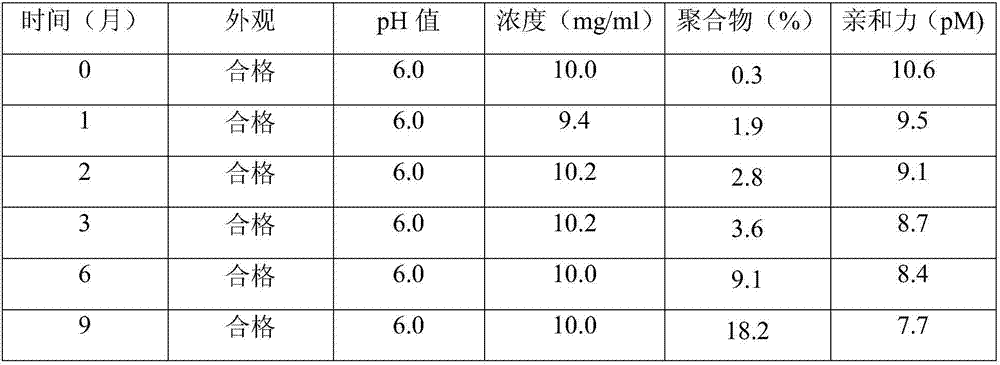A pharmaceutical composition containing a fusion protein for inhibiting angiogenesis and its application
A fusion protein and angiogenesis technology, applied in the medical application field, can solve the problems of reduced protein activity, reduced therapeutic effect, toxic and side effects, etc.
- Summary
- Abstract
- Description
- Claims
- Application Information
AI Technical Summary
Problems solved by technology
Method used
Image
Examples
Embodiment 1
[0034] Example 1 Stability study of the original formulation of 10mg / ml FP3 fusion protein in 3ml glass ampoule at 4°C
[0035] The prescription is as follows:
[0036]
[0037] After changing the protein stock solution, aseptically dispense it into 3ml glass ampoules, reserve samples at 4°C, and measure at 0, 1, 2, 3, 4, 5, 6, 7, 8, 9, 10, 11, and December Samples, stability determined by SEC-HPLC. The results showed that the formulation could not effectively inhibit the formation of polymers, resulting in a decrease in product purity and a decrease in affinity with VEGF, which may induce an immune response after entering the body.
[0038] Table 1. Stability of 10mg / ml FP3 fusion protein at 4°C
[0039]
[0040]
Embodiment 2
[0041] Example 2 Stability study of 10mg / ml FP3 fusion protein in 3ml glass ampoule at 4°C
[0042]
[0043] After changing the protein stock solution, aseptically dispense it into 3ml glass ampoules, reserve samples at 4°C, and measure at 0, 1, 2, 3, 4, 5, 6, 7, 8, 9, 10, 11, and December Samples, stability determined by SEC-HPLC. The results showed that the formulation could not effectively inhibit the formation of polymers, resulting in a decrease in product purity and a decrease in affinity with VEGF, which may induce an immune response after entering the body.
[0044] Table 2. Stability of 10mg / ml FP3 fusion protein at 4°C
[0045] time (month) Exterior pH value Concentration (mg / ml) polymer(%) Affinity (pM) 0 qualified 7.7 10.1 0.2 10.7 1 qualified 7.9 10.1 2.0 9.9 2 qualified 7.7 10.7 3.2 9.3 3 qualified 7.8 10.6 5.4 8.4 6 qualified 7.7 10.3 9.9 8.1 9 qualified 7.5 10.1 13.1 8.5 12 ...
Embodiment 3
[0046] Example 3 Stability study of 10mg / ml FP3 fusion protein in 3ml glass ampoule at 4°C
[0047]
[0048] After changing the protein stock solution, aseptically dispense it into 3ml glass ampoules, reserve samples at 4°C, and measure at 0, 1, 2, 3, 4, 5, 6, 7, 8, 9, 10, 11, and December Samples, stability determined by SEC-HPLC. The results showed that the formulation could not effectively inhibit the formation of polymers, resulting in a decrease in product purity and a decrease in affinity with VEGF, which may induce an immune response after entering the body.
[0049] Table 3. Stability of 10mg / ml FP3 fusion protein at 4°C
[0050] time (month) Exterior pH value Concentration (mg / ml) polymer(%) Affinity (pM) 0 qualified 7.9 10.2 0.3 10.4 1 qualified 7.9 10.2 1.4 10.0 2 qualified 7.8 10.6 2.6 9.7 3 qualified 7.8 10.7 3.6 8.1 6 qualified 8.1 10.5 9.4 7.9 9 qualified 8.3 10.1 18.5 9.7 12 ...
PUM
 Login to View More
Login to View More Abstract
Description
Claims
Application Information
 Login to View More
Login to View More - R&D
- Intellectual Property
- Life Sciences
- Materials
- Tech Scout
- Unparalleled Data Quality
- Higher Quality Content
- 60% Fewer Hallucinations
Browse by: Latest US Patents, China's latest patents, Technical Efficacy Thesaurus, Application Domain, Technology Topic, Popular Technical Reports.
© 2025 PatSnap. All rights reserved.Legal|Privacy policy|Modern Slavery Act Transparency Statement|Sitemap|About US| Contact US: help@patsnap.com



